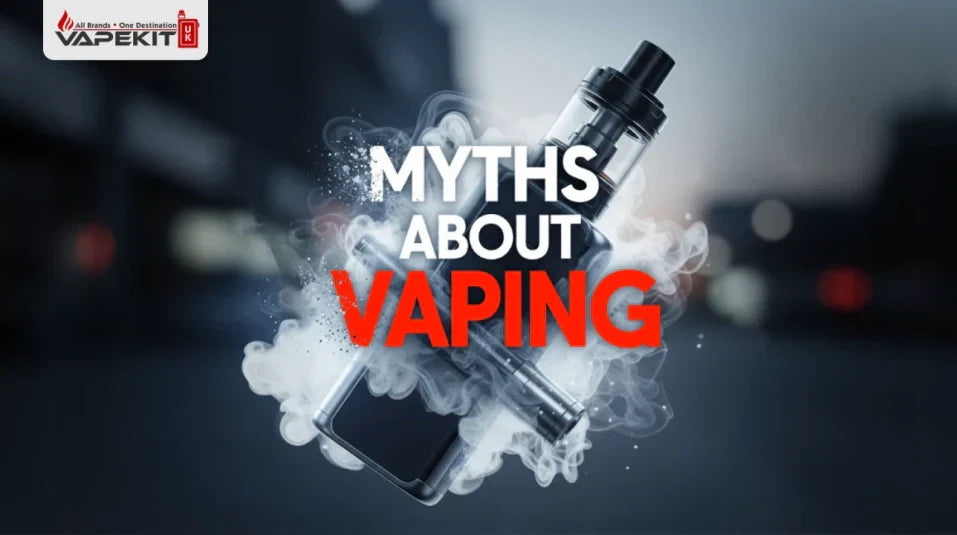
10 Common Myths About Vaping: Beginner’s Guide 2025
Everyone has something to say about vaping. Some claim it is safer; others claim it is just as bad as smoking. The reality? Most of these opinions are totally wrong and are just myths that keep perpetuating over time.

These common myths about vaping usually come from old studies, scary headlines, or just people repeating what they’ve heard. For example, many think vaping is the same as smoking—but it’s not. Vaping doesn’t burn tobacco, so there’s no tar or smoke, only vapour.
Still, these myths about vapes confuse people and make it hard to know what’s real. That’s why we’re here—to clear up the biggest myths and give you the facts in a simple way.
Myth 1: Vaping Is Just as Dangerous as Smoking
Many people believe vaping is just as dangerous as smoking, but that’s not true. Smoking burns tobacco, and that smoke is filled with tar and thousands of harmful chemicals. That’s what makes cigarettes so damaging.
Vaping works differently. There’s no burning, no tobacco, and no smoke—only vapour. And that simple difference makes vaping far less harmful than smoking.
It’s not 100% risk-free, but saying vaping is “just as harmful” as cigarettes is simply a myth.
Myth 2: Vaping Always Leads to Smoking
A lot of people think that if someone starts vaping, they’ll eventually start smoking. But that’s not true.
Most people who vape are already smokers or are trying to quit smoking. Vaping is usually a safer alternative, helping them reduce cravings or even stop smoking altogether.
So, vaping doesn’t “always lead to smoking.” In fact, for many, it’s a step away from cigarettes, not toward them.
Myth 3: All E-Liquids Contain Dangerous Chemicals
Many people think vape juice is full of harmful chemicals, but that’s not true.
Most e-liquids are made from just a few simple ingredients: propylene glycol (PG), vegetable glycerine (VG), nicotine, and flavourings. These are safe, and many are even found in everyday foods.
Of course, it’s important to buy from trusted brands, but thinking all e-liquids are dangerous is just a myth. Vaping is much cleaner than smoking, and the ingredients are simple and controlled.
Myth 4: Nicotine = Cancer
A lot of people think nicotine causes cancer, but that’s not true. Nicotine is the addictive part of cigarettes and vapes, but it doesn’t cause cancer by itself.
The real danger comes from smoking. When tobacco burns, it produces smoke full of harmful chemicals—that’s what damages your lungs and body.
Vaping works differently. There’s no burning—just vapour with nicotine, which satisfies cravings without exposing you to the harmful smoke.
Nicotine can affect your heart or blood pressure, but it’s not the reason people get cancer. So, if you’ve been worried about nicotine, now you know: the smoke, not the nicotine, is the real problem.
Myth 5: Vaping Causes Popcorn Lung
You might have heard people say, “Vaping can give you popcorn lung.” It sounds scary, but it’s not true.
Popcorn lung: A rare lung disease that was linked to workers who breathed in a chemical called diacetyl, used in popcorn factories. Breathing large amounts of it over time can harm the lungs.
The good news? Modern e-liquids don’t contain diacetyl. In the UK, it’s been banned since 2016. So, as long as you choose trusted brands, vaping won’t give you popcorn lung.
The takeaway? Enjoy vaping safely with quality products, and don’t let this myth worry you.
Myth 6: Vaping Devices Always Explode
People have fears relating to exploding devices from stories they have seen in the news. However, the reality is these are very rare.
Most situations have occurred, in fact, with either a damaged device, damage done by a charger used, or cheap batteries. It's not the vape that is dangerous; it is the vape and what to do with it.
To stay safe:
-
Choose reputable brands that adhere to safe standards.
-
Use the charger that comes with the device.
-
Check the device regularly for cracks or damage.
-
Keep it away from extreme heat or cold.
When these simple steps are followed, vaping is safe, and the idea that devices “always explode” is just a myth.
Myth 7: Secondhand Vape Clouds Are Just Like Smoke
Many people worry that being near someone vaping is just like being around cigarette smoke. The truth is, it’s very different.
Cigarette smoke comes from burning tobacco and contains lots of harmful chemicals that can linger in the air. Vaping, however, turns a liquid into vapour. This vapour may have some chemicals, but far fewer than cigarette smoke.
It’s still wise to avoid inhaling vapour directly, but secondhand vape clouds are much safer than secondhand smoke.
So, while it’s not completely harmless, it’s not the same as smoke, and knowing this helps make better choices for yourself and those around you.
Myth 8: Flavoured Vapes Are Only for Kids
Many people think flavoured vapes are made just to attract kids. That’s not true—adults enjoy them too.
Flavours like fruit, menthol, or dessert make vaping more enjoyable and can help adults switch from smoking to a safer alternative.
Flavoured vapes don’t have all the harmful chemicals found in cigarettes. It’s still important to use them responsibly and pay attention to the nicotine level.
So, flavoured vapes aren’t just for kids—they’re mainly for adults who want a safer and tastier vaping experience.
Myth 9: Vaping Doesn’t Help Smokers Quit

Some people think vaping can’t help smokers quit. That’s not true. Many people have successfully used vaping to stop smoking cigarettes.
Vaping feels familiar because it mimics the hand-to-mouth action and the throat hit of a cigarette. This makes it easier for smokers to switch. Over time, people can reduce the nicotine in their e-liquids and gradually stop nicotine altogether.
While vaping isn’t completely risk-free, it’s much safer than smoking. Cigarettes burn tobacco and release harmful chemicals like tar and carbon monoxide. Vaping avoids burning, which reduces exposure to these dangerous substances.
Many smokers have switched to vaping, cut down on nicotine, and eventually became smoke-free—often feeling healthier and more energetic.
The takeaway? Vaping can be an effective way for smokers seeking to quit. It’s a safer, effective way to move toward a smoke-free life.
Myth 10: Vaping Is Just a Passing Trend
Many people think vaping is just a fad that will fade away. The truth is, vaping has become a reliable way for many people to quit smoking.
Vaping is safer than cigarettes because it doesn’t burn tobacco, so it avoids harmful chemicals like tar and carbon monoxide. With so many flavours and nicotine strengths, vaping can be tailored to what each person needs, making the switch to vaping from smoking is easier and more enjoyable.
Vaping has come a long way as an industry, with many types of products available, ranging from basic prefilled vapes to sophisticated pod systems.
The point? Vaping is not just a trend, it is a practical solution for anyone looking to quit smoking and make healthier lifestyle choices.
FAQs About Myths About Vaping
1. What are the most common myths about vaping?
People often believe vaping is just as harmful as smoking, that e-liquids are full of dangerous chemicals, or that it always leads back to cigarettes. These are some of the myths about vaping that cause unnecessary confusion.
2. Is vaping really safer than smoking?
Yes. Vaping doesn’t burn tobacco, which means it avoids tar and carbon monoxide—the two most harmful parts of cigarette smoke.
3. Does vaping cause popcorn lung?
No. The chemical linked to popcorn lung (diacetyl) is banned in UK e-liquids, so regulated products don’t carry this risk.
4. Are flavoured vapes only meant for kids?
Not at all. Flavours are designed to help adults enjoy the switch from smoking. Strict rules ensure these products aren’t marketed to children.
5. Can vaping help someone quit smoking?
Yes, many smokers find vaping useful because it provides nicotine without harmful smoke, making the switch easier.
6. Are all e-liquids full of harmful chemicals?
No. Most e-liquids contain just a few ingredients—nicotine, vegetable glycerin, propylene glycol, and flavourings. In the UK, these are closely regulated.
7. Do vaping devices really explode?
Explosions are very rare and usually happen only when fake or faulty devices are used, or when they’re handled incorrectly.
8. Is secondhand vapour just as harmful as cigarette smoke?
No. Secondhand vapour has far fewer harmful substances compared to smoke, making it less risky for people nearby.
9. Does nicotine itself cause cancer?
Nicotine is addictive, but it’s not the part that causes cancer. The real danger comes from tar and toxins created by burning tobacco.
10. Is vaping just a passing trend?
No. Vaping has become a long-term alternative for many smokers and continues to grow as a safer choice.
Conclusion: Cutting Through the Smoke and Myths
Vaping can be a helpful and safer alternative for people who want to quit smoking. While there are many myths about vaping, the truth is that vaping avoids many harmful chemicals found in cigarettes. Nicotine is still present, so it’s important to use e-liquids responsibly and pay attention to the strength. Flavoured vapes aren’t just for fun—they are designed for adults to make quitting smoking easier and more enjoyable. Thousands of people have transitioned from smoking to vaping, and eventually quitting altogether.
When devices are used properly and bought from trusted sources, they are safe to use, and secondhand vapour is much less harmful than cigarette smoke. In summary, the main benefit of learning the myths related to vaping is so that people can make informed decisions regarding their health. While vaping is not without its faults, it is a practical and effective way to help smokers transition into a healthier smoke-free lifestyle. As long as they are informed, and using quality products, then they will succeed in making these changes.




